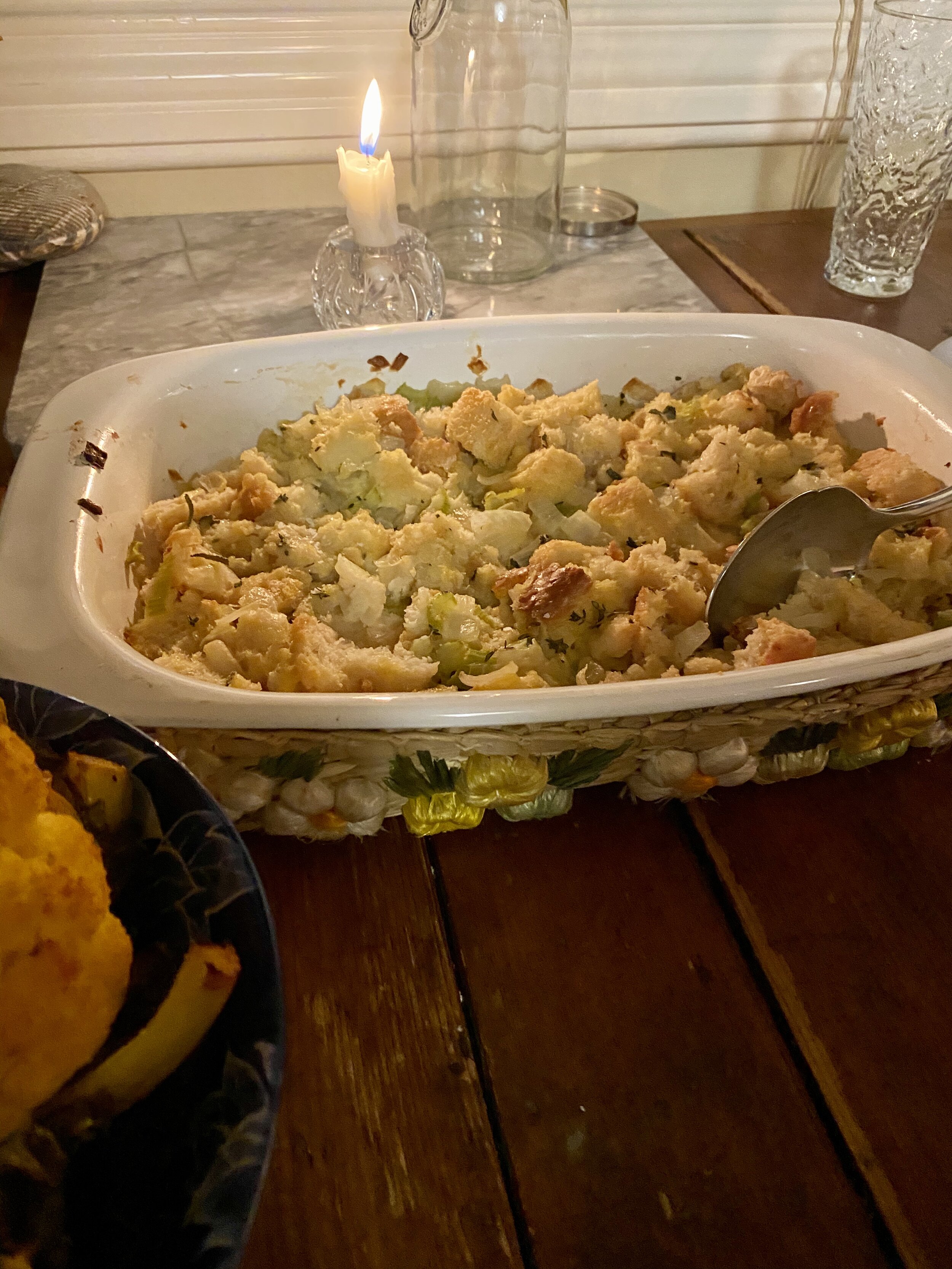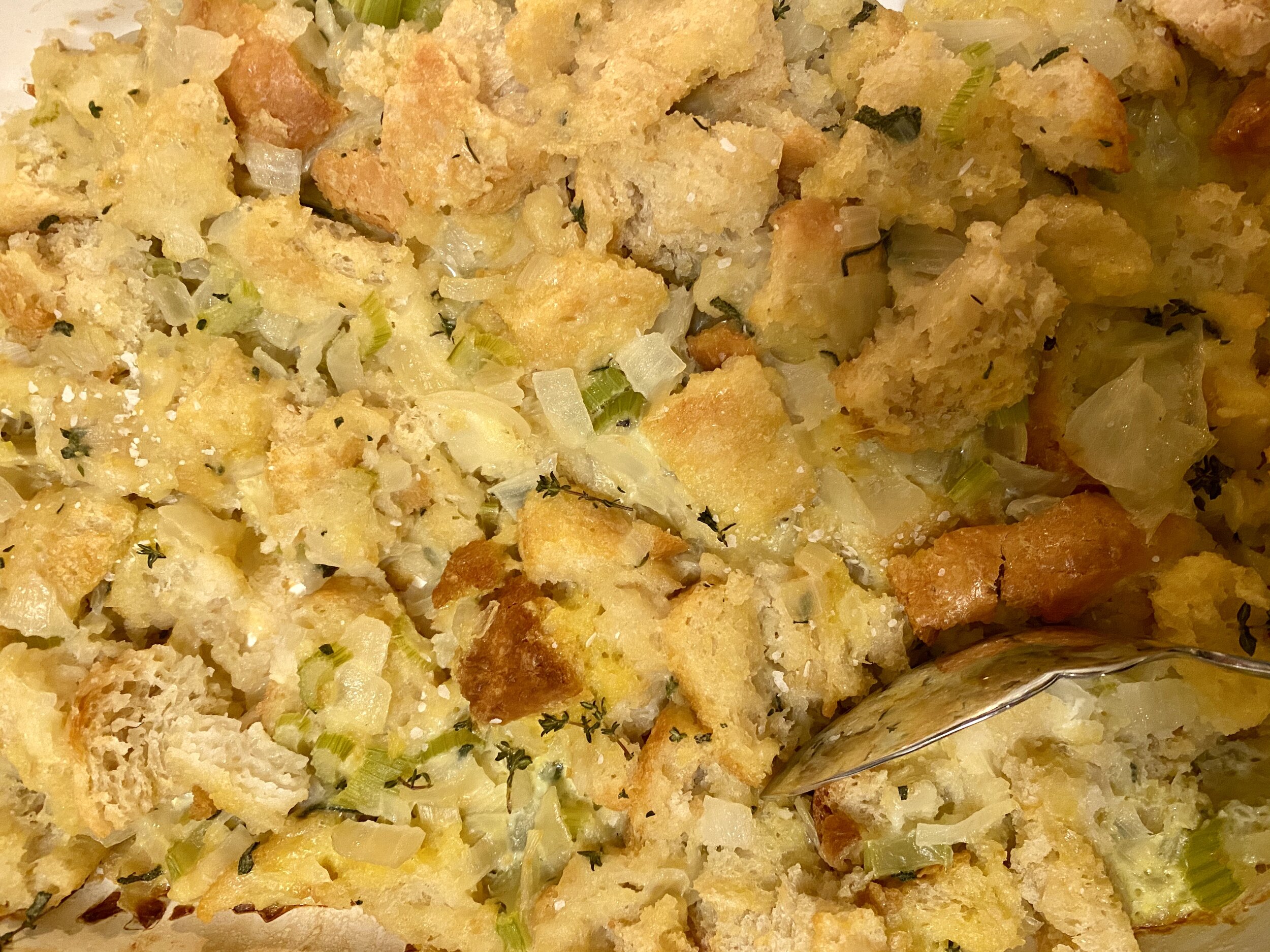At our house this year, though we’re still trying to cultivate gratitude, we’re also keenly aware of the holes—the guests who won’t be sitting around our Thanksgiving table, Sam’s exhaustion from trying to find viable treatments for COVID-19, and the painful increases in food insecurity. On The Splendid Table podcast, we heard of people who plan to incorporate mourning into their Thanksgiving meal, eating only the one or two dishes they normally contribute when gathering with others for this holiday.
We’ve had a hard time deciding which recipe to post, wanting to provide a reliable recipe that tastes good for those who plan to cook, especially those for the first time preparing the whole meal this year, but also keenly aware of so many layers of loss in so many lives right now. If I (Kate) only ate one thing for Thanksgiving, it would be this stuffing, and it’s probably the least expensive item on the table, competing with the green peas that were a luxury for Sam’s Thanksgiving meals growing up. But more sustaining than the peas. Please send us a note if you have any questions. Whatever you want your meal to look like this year, we’d love to help it meet your aspirations.
If it weren’t 2020, we’d be gushing over how much we love this stuffing, with it’s crisp exterior, light, moist insides, and perfect balance of flavors: beautiful on its own, wonderful with mashed potatoes, gravy, sweet potatoes, turkey, cranberry sauce—however much you can fit onto a fork.
Our Favorite Stuffing
serves 6
8 slices bread crusts, optional to remove the crusts, toasted and cubed (try toasting the cubes at 350 degrees for 20 minutes) ( inexpensive ranch-style sliced white bread works well; Amelia bakes this.)
1/4 cup (1/2 stick) butter, plus more for greasing the baking pan
1 large yellow onion, chopped into 1/4-inch dice
1 large or 2 small stalks celery, sliced thin
3 sage leaves, rolled together and sliced to make a chiffonade
Several sprigs fresh thyme (or scant 1/2 teaspoon dried)
1 15-ounce can broth (chicken or vegetable)
2 eggs
1/2 teaspoon plus a pinch kosher salt
(Our mom/Grandma likes a little diced apple and dried cranberries in her stuffing. If you do, too, add 1 small apple, cut into a 1/4-inch dice and/or 1/4 to 1/2 cup dried cranberries. If you’re adding the fruit, you may as well sprinkle 1/2 cup sliced almonds or pine nuts over the top before placing it in the oven.)
Heat the oven to 325 degrees F.
Place bread cubes onto a baking sheet and leave for twenty-four hours to dry or toast at 325 degrees for 20 minutes to dry them faster.
Place the dried cubes into a buttered 2-quart casserole dish. Melt the butter in a sauté pan over medium-high heat, then sauté the onion and celery with a pinch of salt in it for 5 to 7 minutes, until translucent (turn the stove down to medium if they start to acquire too much color). Add sage for the last two minutes of the sauté, then add thyme at the end. Add broth and 1/2 teaspoon salt to the pan and bring it to a simmer for about a minute.
Take note: here is the step that sets this stuffing apart from any other and lets it be crisp and brown on top and light and moist in the middle: pour the contents of the saute pan over the bread cubes and let stand for 15 minutes.
In a small bowl, whisk together the eggs. After the 15 minutes have passed, pour the eggs over the soaked bread and stir gently until evenly blended (just before this gentle stirring would be the time to add apple and cranberries, if you wish to).
Sprinkle with slice almonds or pine nuts if you’d like, then bake uncovered for 50 minutes, until nicely browned on the top. Let stand for 10 minutes before serving. Or cool, cover, and refrigerate the day before, then reheat for about twenty minutes in the oven just before dinner.


